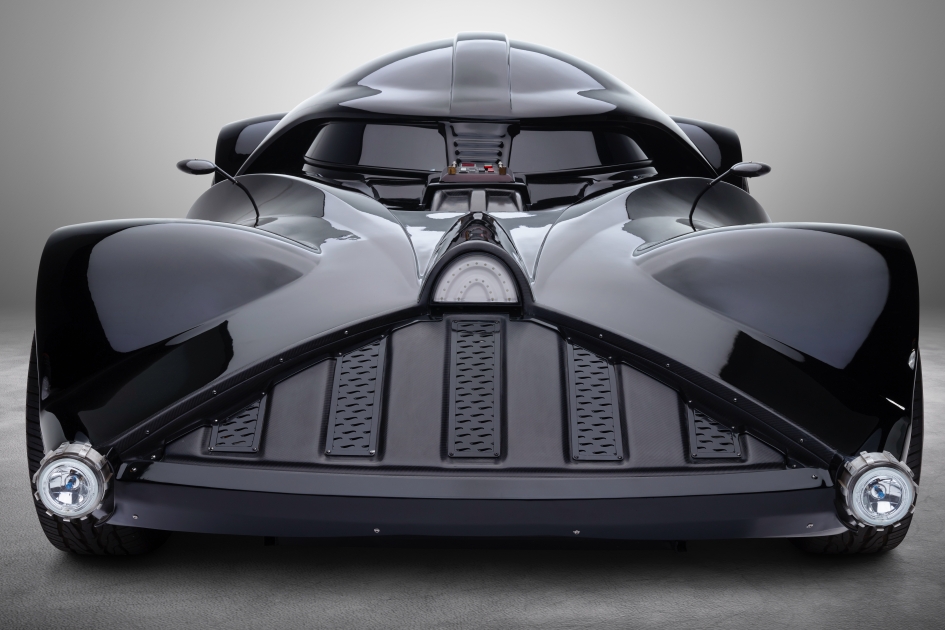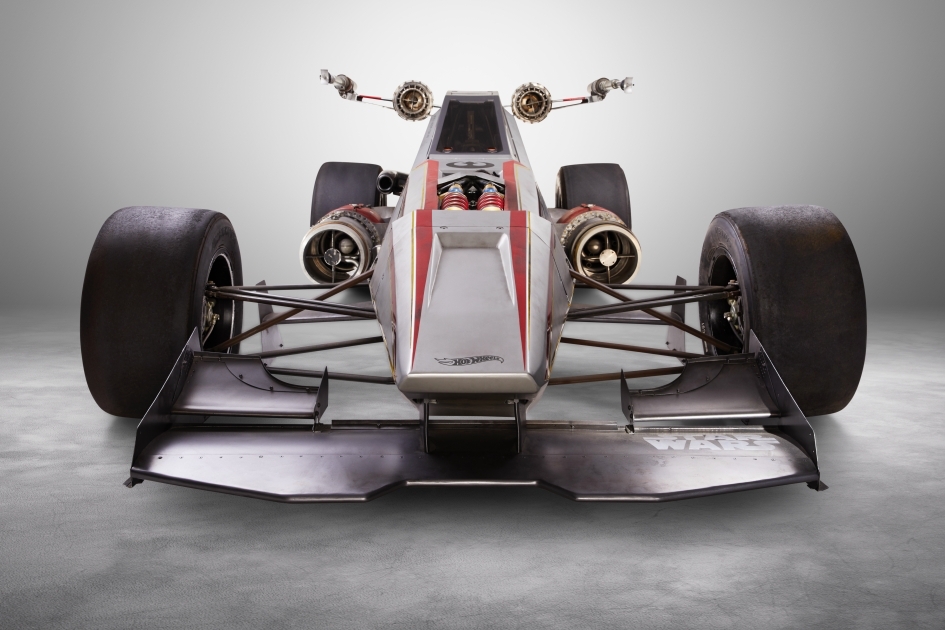Hot Wheels manufactures more cars than any OEM on earth. Okay, most of these are just toy cars. As successful as the California-based company is, there comes a time to push the boundaries. Sure, Hot Wheels (and parent company, Mattel) has a lengthy history of turning big cars into hand-size replicas. Yet, the company, with the help of imaginative and talented designers, is flipping the script.
Bryan Benedict, Design Director of Hot Wheels, is no stranger to designing cars of all shapes and sizes. Bryan is enthusiastically pulling back the curtain on taking a toy and creating a life-size running vehicle, and more.
Exclusive Interview by John Grafman
Images courtesy of Hot Wheels
Bryan Benedict: We’ve got quite a few cars in our, what we call, Hot Wheels Garage of Legends. We have about 25 to 30. I can’t remember the exact number now. We built our very first full-size Hot Wheels in what was supposed to be for the 30th anniversary of Hot Wheels in ’98. That was the Twin Mill.
The Very First Hot Wheels Original
Twin Mill has the distinction of being the very first Hot Wheels Original. And so, in 1968, all the Hot Wheels castings were licensed cars, basically. In ‘69 is when Twin Mill came out and that was an all-new design by Ira Gilford, internal Hot Wheels Designer.
To celebrate the 30th anniversary, we wanted to celebrate that car and make it a full-size car. We worked with Boyd Coddington, back then. And of course, that’s at the same time he went through bankruptcy and everything, so the car didn’t end up finally getting built till 2001. So, it didn’t end up being available for 30th anniversary celebration.
There’s a long, interesting, funny story around that that. The car almost never got done, but there were some individuals here who were determined to make it happen. And it finally did, but was unveiled at SEMA, I believe, in 2001.
Hot Wheels’ Double Loop Dare at the X Games in Downtown L.A.
Since then, we’ve built a number of cars for a number of different purposes. Some are purpose built for stunts. For example, we did the Double Loop Dare in downtown L.A. for the X Games, where we ran two cars through a full-sized loop on Figueroa Blvd. That was pretty dramatic, and we had Greg Tracy and Tanner Faust driving the cars. That was exciting. We broke a world record with that.
Actually, the Jump Truck came first. That was at Indy, on May 29, 2011, but in the infield at Indy. We launched a truck off the top of what was basically a full- size replication of the clip from back in the day, where you clipped it (the track) onto your door and then you’d run your Hot Wheels off the top of the door and do the big jump. We created a giant door at Indy, with the orange track coming off it. The truck did the longest jump ever. That was pretty exciting!
And then we did a Corkscrew Buggy that did a world record-breaking corkscrew jump, which was really, really cool. And then some cars [were] built to capture a specific genre when the G-Machines scene was hot, taking muscle cars and kind of updating them, making them really clean, big wheels and the whole thing.
We did the Pontiac GTO to celebrate that scene, and we had a whole line around that called G-Machines. We debuted that at SEMA. We’ve done some partnerships with OEMs as well. In 2013, we unveiled the Hot Wheels Camaro, which was first time you could buy an actual Hot Wheels car at a car dealership, so that was exciting. And then, we revisited that with General Motors for our 50th anniversary when we did the Hot Wheels 50th Anniversary Edition Camaro. And that, from what I understand, is the quickest selling special edition of Camaro that year. We’ve got a couple of partnerships like that. We have examples of those cars in our Garage of Legends, as well.
Porsche, Mobil 1, and the Dirtmeister 944 at Rennsport Week
Most recently we did the partnership with Porsche and Mobil 1, and we unveiled the car at Rennsport Week. I worked on that with Patrick Long, and we created an off-road, safari Porsche 944, and we treated it to a shooting brake. We called it the Dirtmeister 944. And we put a fun, little shooting brake backend on it, which allows you access to all the gear back there and pull the [spare] tire out. And we intend to do some, actual rally racing with that, in the coming year. Every kind of build, there’s a different purpose for it, or you know there might be a specific objective. And so, it’s not always the same thing, right?
Actually, we also built the Beach Bomb. The pink Beach Bomb has the distinction of being the most expensive Hot Wheels ever sold. There’s a collector, Bruce Pascal, who purchased one little prototype pink Hot Wheels Bus for $72,000, because it’s believed to be the only one in pink. There were very few, just a handful of these prototype buses that got out into the world. It was like kind of the Holy Grail of Hot Wheels collecting, like everybody’s looking for this pink bus. He got it for $72,000 and now has a value now over $200,000, because he’s been offered that much and turned it down. He says it’s worth more than $200,000. To commemorate the most expensive Hot Wheels ever sold, we built a full-size version of the pink Beach Bomb, which is here in the studio next to our designer.
And then, we did things like the partnership with Star Wars Lucasfilm. We did the Darth Vader car, and then we followed that up with the X-Wing car. That was very much a celebration of a new partnership, and a new sort of form factor that we wanted to highlight. We debuted both of those cars at a Comic Con.
The Darth Vader cars, which I worked directly on – I designed, and we kind of knew going in, as we were setting up to design the character car line for Lucasfilm, that we wanted to build a full- size car. So probably pretty early on, we determined that we wanted that to be Darth Vader. In that case, it was really designing the toy and the full-size car at the same time. Because I was designing the toy, knowing it was going to be a full-size car, it really wasn’t much of a departure. The funny thing with us designers is, we’re always thinking of every car that we’re designing, we think of it as a real car. When we’re doing a fantasy car, no matter how crazy it is – the donut car or whatever – in our minds we think of it as a full-size car. What would that be like as a full-size car? Where would the engine be? Because, you don’t want to design something that looks fake, that doesn’t ever look like it could be a real car, right? So we always try to think of like, well, OK, what’s the power plant? And even sometimes guys will design an engine that’s in the interior part. You would never see it unless you drill the thing apart. But there’s an engine in there, you know. That’s just kind of how crazy we are.
Darth Vader Car Comes Alive
When I was designing the Darth Vader car, I was kind of envisioning it as either a Viper platform or a or a Corvette platform. In the end, we went with Corvette platform, but I remember some of my early sketches, I literally found images of a Viper without the body on her. I like to have naked, bare bones, a Viper chassis, and bulwark, and everything. I’m sketching over that to make sure that it could fit the engine, and everything fits in there, the radiator, and all that. I worked to those dimensions, kind of thinking, ‘OK, it’s going to be a real car’, not knowing at that point really what car, what platform, we’re going to go with. But it very easily translated to the Corvette platform. And everybody’s like, ‘there’s no way you’re gonna be able to put that body on the Corvette and make it look right, you know.’ But I sketched it out, and it worked. The dimensions, fortunately, worked really well. We did have to cut off a lot off the back end, that unnecessary stuff on the frame in the back that we didn’t need, and a little bit on the front. But all-in-all, it fit really well, in the end.
A lot of people look at that and think it’s not a real car. Because, the hood is so low there’s no way there’s an engine under there. It fits right in perfectly. And then also, they think there’s no doors. How do you even get in? But the helmet actually lifts off. It’s on hydraulics, and it raises. My whole concept behind that was thinking of the movie, it was in the chamber that the helmet lifts off his body like that. I wanted to kind of replicate that with the car build. And then on the inside there’s hoses, and tubes, and everything to kind of emulate the inside of the helmet.
ADO: Do you do the builds in-house or do those get sent out, or a little bit of both?
Bryan Benedict: We partner with most of our builds. Recently, we’ve partnered with Action Vehicle Engineering – Billy Hammond and his team – up there in Chatsworth. Their primary business has been building cars for entertainment, movies, TV shows, commercials, whatever. And he used [to be with] Picture Car Warehouse. Those are the guys that have worked on the vast majority of our builds. Some of the earlier stuff, you know, we had (Chip) Foose work on stuff. We had Boyd Coddington, Steve Strope – Purevision, up in the Valley. He did the GTO for us. And then, (George) Barris actually did the pink Beach Bomb. But Billy’s been a great partner.
Man, when I was working on that build, those were some grueling days because I would go to his shop in the morning, get as much done as I could on the build. Because of my sculpting background, I was just physically scraping foam, shaving, and sculpting the car. All those forms you see there are what I shaved down. I was going every day to shop and working with him and then in the evenings doing all of my day job. It was pretty brutal. It was a really, really quick turn-around because we had to have the car ready for Comic Con. I want to say it was an 8- week build. It was very short, truncated timeframe, something like that. Yeah, that was a lot of fun, though.
Creating the Darth Vader Car for Comic-Con was no Laughing Matter
And then you know, more recently, I did the Dirtmeister build, and that was with Patrick Long. We worked with Jimco Racing and Kundensport up in Oxnard. For that, Patrick was really responsible for the build, so he was the one very directly working with the different build teams. Kundensport did all their body mods and then Jimco did all of the off-road components. And then they’d check in with me. I was overseeing seeing things from the Hot Wheels design perspective, but really, he was responsible for the build. I was less involved than the Darth Vader build, but I was very much hands-on.
Yeah, it’s really exciting to see a little toy car come to life as a full-size car. And it’s kind of a cool testament to our designs, because we really do design things so that they can be real cars, no matter how fantastical they are.
ADO: The cars like the Camaros, those were already street-able cars. Of the ones that are like the Darth Vader vehicle and those types, how many of those are actually drivable and street legal?
BB: I would like to say they’re street legal and some of them could be, but we just haven’t bothered to go through the process. But I will say, all of them drive and function. We wouldn’t build something unless it was going to be a real car. We really want to cement in people’s minds that Hot Wheels is an authentic part of car culture. And so, I think an important part of that is, our cars are drivable – functioning.
Our favorite car is a high-performance car, it’s a Corvette (ultimately becoming basis for the Darth Vader car). It was made to be ‘street legal’, that was the whole intent when we built it. My whole intent in designing everything was that it was going to be a street legal. You know, it’s on an episode of Jay Leno’s Garage. And of course, Jay can do whatever he wants. Jay drove all over Burbank with me, and you know nobody’s going to stop us. Yeah. So that was a lot of fun.
Jay Leno Can Do Whatever He Wants
ADO: Right now, there’s a number of companies that are springing up that are low volume manufacturers. And as you said, your cars are already, at least from an aesthetic design perspective, created thinking about this (being street legal). Could you even conceive of a Hot Wheels (street car), something that’s not necessarily an OEM vehicle?
BB: Yeah, limited run or whatever, A Boneshaker or whatever. Absolutely, I love that idea. And it’s certainly not out of the question. I personally think that there could be some huge demand for something like that. Yeah.
ADO: Well, how many people have owned Hot Wheels over the decades? Probably at least a few people?
BB: Yeah, absolutely. Absolutely.
That one is street legal (Boneshaker). That’s the one with the skull face on the hot rod, the skull face design by Larry Wood. So, we have two, now. People don’t realize there’s two. They think it’s the same car, but…
ADO: What’s that based on?
BB: So, it’s like a Model A, but it’s not. It’s built from the ground up. But I believe that they went with a Cobra kit chassis. I forget exactly which program they went with. The new one is fully worked out to be street legal, whereas the other was to be shown at Legends [Tour].
ADO: So, we can expect to see those at dealerships soon?
BB: Yeah, I hope so (laughing)!


































